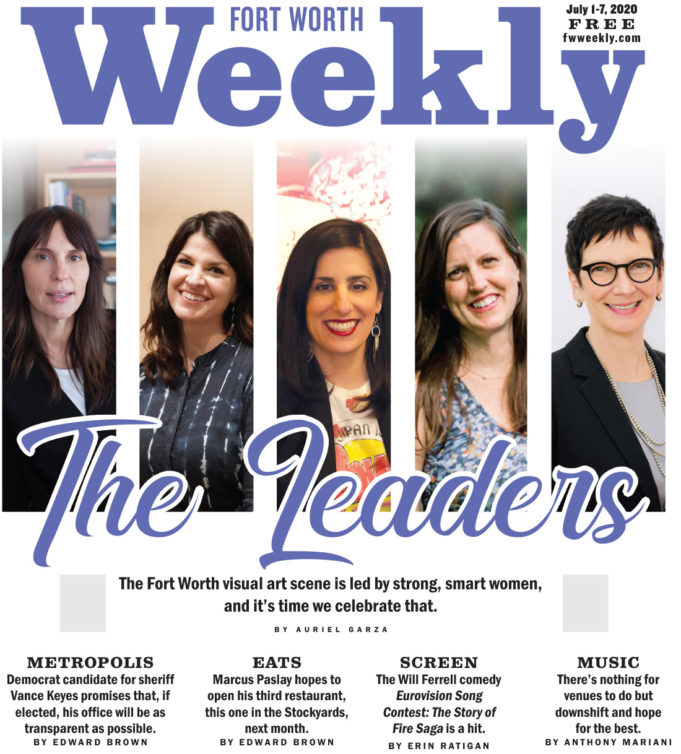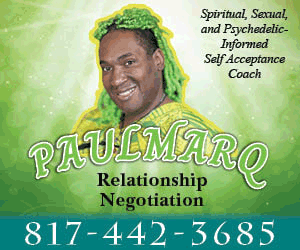Three months ago, before the arrival of COVID-19 and the latest wave of demonstrations against police brutality and in support of Black lives — long before Spring Gallery Night was canceled and before our community began to show its remarkable strength and solidarity in a crisis — I had the very special opportunity to sit down with five of Fort Worth’s most outstanding leaders in the local visual art community, all of them women and all of them white.
I asked these women to discuss their working life, past experiences, upcoming projects, and any advice they might have for aspiring leaders. My goal was to shine a light on some of the hardest working women of Fort Worth, highlighting their accomplishments and any challenges they wished to speak to with regard to their position and journey to leadership.
I arrived at each interview with the same 25 questions. All of the interviews took just over an hour. What surprised me most was how generous these women were with their time, as well as their openness and excitement to share their stories, lessons learned, and hopes for the future.
In terms of recognizing outstanding women leaders in our community, this is just the beginning. This feature primarily focuses on the visual arts and specifically a handful of women who are in high-level leadership roles at some of our city’s largest and longest-standing arts organizations. They are builders and directors of teams. They are the visionaries of dreams that once brought to fruition will have deep ripple effects in our community.
Make no mistake, we are fortunate to have so many women at the helms in Fort Worth, but in light of the recent protests and #BlackoutTuesday, I feel I should also mention that my search for women of color in top-level leadership came up short. That is not the focus here. Future articles are needed to address the causes and consequences of this issue. Systems of inequity run deep in this country, and the results play out every day in every aspect of our lives, even within our beloved art community and its most treasured organizations.
My hope is that the Weekly and other publications will continue to highlight all of the amazing work that’s being done by women all across this city. We are flush with talent and passionate women working tirelessly at all levels every day to propel Fort Worth’s visual art community, many of whom are women of color. The list goes on, and the work continues.
Amanda Blake
Amanda Blake is the director of education, library, and visitor experience at the Amon Carter Museum of American Art. Born in Oklahoma and raised in Kansas, she has been a resident of North Texas since 2004. After earning degrees at Oklahoma State University and the University of North Texas, she joined the staff of the Dallas Museum of Art in 2006, later serving as interim director of education (2015–2017). Blake joined the staff of the Amon Carter in January 2018. She is a proud wife and mother of one rambunctious toddler and a very handsome 12-year-old Westie named George.
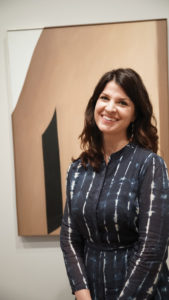
Photo by Nick McClanahan.
I’ve always enjoyed experiencing art and making art. My high school art teacher really helped me to feel confident to pursue studio art in college. My high school partnered with the Wichita Art Museum and their educator there. We went and learned in the galleries pretty frequently, and it helped me to understand what museum education was and led me to pursue that as a career. It also helped me to understand the importance of art museums and the impact they can have on the life of a child and their development. That’s also a driving force for us in education at the Amon Carter.
What about work/life balance and having it all?
I think it’s important to define what it means to “have it all.” It’s probably different for everyone, but I think that it is possible for men and women to feel satisfied, but I would also love for people to put less pressure on themselves and maybe focus on acceptance in some areas.
I have accepted that I’m always going to be behind on laundry, and I am really fortunate to have a very supportive partner who prioritizes the care of our child, dog, and home as much as I do. I definitely could not be a working mom at this level without a supportive spouse who is so excited to have an equal share. I would also love to see that question being asked as much of men as I see it being asked of women.
What’s a challenge for today?
You’re always reading about the quick growth of the city and how Fort Worth is maintaining its relevance to people who are on the outskirts of town. I didn’t realize how large the city was until I started looking at the different districts in terms of the outreach we’re doing here. One challenge we face is keeping up with that growth.
I think that we do a great job of listening to our community to determine our next move and learning where we can help to fill gaps. We’re also working with various community groups as we continue to evolve as a museum. We also value artists here, not only as creative voices and artmakers but as participants in the community, so whether it’s listening to our artists or fourth-grade teachers from [the Fort Worth school district] or the head of a community center, we’re using those voices to inform our practice and create shared goals and long-term sustainable partnerships throughout our community.
Please name one proud moment or accomplishment.
In my leadership role, I’m not spending as much time in the galleries as I used to, activating a work of art through a program or an event with people. Something that has helped me to overcome this bittersweet moment in my career is being able to develop a team and watch them grow and really think about the talent of my staff and how different people excel at different things and how we can all work together on our same goals. Empowering a team is incredibly rewarding, and I have found that I really enjoy helping others grow.
Do you have any advice for other leaders?
Teams are everything. No one can do everything by themselves, and I think that the more diverse perspectives you can bring together on a team, that only makes things better. … I think that it’s important to maintain focus on your own achievements, growth, and strengths but to then also take that energy and try to empower others, especially women.
My advice for other leaders is to create opportunities and nurture talent. Really invest in things like internships and fellowships and make space in the budget to pay these individuals. I also think it’s important for aspiring leaders to have female role models who’ve excelled and broken the glass ceiling. I had the great luck to work with Bonnie Pitman for a few years at the DMA. She came from art museum education and became the director of an art museum. She was also the reason that I wanted to work at that museum. I think having strong mentors and role models helps you to stay focused and keep your eye on the prize. Bonnie would say, “Just keep swimming.” She has a really great duck analogy. She says you’re gliding along and you’re just a smooth graceful duck, but no one can see how fast your feet are going beneath the water.
What are some upcoming projects?
I’m looking forward to the growth of our Carter Community Artist initiative. We’re in our second year, and I’m excited about expanding the pool of local artists that we work with, who know us, and that we can call on anytime that we would love to have an artist’s perspective on something, whether it’s writing a school tour or when we want someone who is well-versed in photography to work with a local community center or do murals in schools.
Our Carter Community Artists help us plan programs, but they’re also actively teaching in the community. Many of them have told me that they really value that time. They might be out talking about a work of art from the collection but then also applying that experience to their process and continuing to explore creative avenues with people in their community.
I’m also excited about continuing to surprise our visitors in the coming months. To match our newly renovated gallery spaces, we have a lot of fun, revamped experiences for people of all ages. In October, we’re planning to have a Fiesta on the Porch that’s related to our installation by Justin Favela. As part of the event, we’ll have live tattooing in the galleries, people from the community are going to fill our parking lot with lowriders, and we’re inviting a local Northside barbecue place to sell brisket tacos. I think that in many ways people will come to find the unexpected here at the Amon Carter.
Lauren Childs
Lauren Childs is an artist and co-founder, owner, and director of Fort Works Art (FWA). After studying theater at Northwestern University, Childs returned to North Texas, where she earned a degree in art history, criticism, and conservation at UTA in 2001. Childs co-founded FWA as a pop-up collective in 2014 and later opened the brick-and-mortar gallery in 2016. The space regularly hosts works by local, national, and international artists. In 2018, Childs launched the nonprofit Gallery of Dreams, which sponsors artist residencies, educational exhibitions, and local school exhibitions, including the Betsy Price High School Art Competition. Childs was born and raised in Fort Worth and is a proud mother of two.
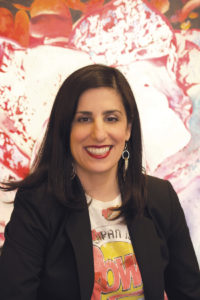
Photo by Ryan Burger
What led you to pursue a career in the arts?
This city led me to pursue a career in the arts. I’ve wanted to be an artist or architect since I was 5. I grew up with the museums and studied art during summer programs here. After attending Northwestern, I came back and studied at UT-Arlington with Benito Huerta, a major artist from our community who later became my mentor. I was his assistant for about three years, and during that time, I learned about the business of art and how it worked in the city of Fort Worth. He was doing massive public art projects and was receiving many accolades.
Then, in my early 20s, I had a collective for about three years. I was the vice president, and we did a lot of pop-up shows that were very similar to how Fort Works Art began 20 years later. I then had a contracting business for about eight years, but the gallery developed very organically. I was painting. I lacked space to show my work, and my friends and I decided to organize a show. It went so well that two years later, I opened a gallery.
What about the day-to-day work/life balance and having it all?
We’re an artist-run space, and I’ve put so much into the gallery both financially and timewise because I love it — showing these artists, to support and advocate for them. Sometimes I think people see this big gallery and assume we must be doing great, but we grind it out here, and my staff is very tiny. We’ve had a lot of employees who have supported this gallery, but for the most part, we’re run by two women: Sarah Colby, my gallery manager, and myself.
My day-to-day? I never know. Owning a business, there’s a million things that can happen, but pretty much every day something really cool happens. You might get an email that somebody wants to do something or hear about an artist who’s achieved something, and no matter how stressful your day is, you can always count on a really cool moment of the day. That’s kind of my mantra around here, to have at least one moment in the day that makes us happy, and I feel like we do.
I have two great kids that keep me inspired and make me want to come to work and do well and make them proud. That’s so important to me. I’m a single mother, and I want them to grow up knowing that Mom was a cultural shifter or somebody who made a difference in the community.
As far as balancing it all, it takes a village. I have the support of my family to help me with my children, and they go to a great school, and so I’m able to feel comfortable knowing that if they’re not with me, they’re in a great space. When we are together, I just make sure that I’m with them. When I go home, for the most part, work is done.
I have always been a woman who’s said I want it all. I want family, career, freedom, equality — I want all of those things, and I’ve fought really hard to have them. At some moments in life, I have had them all. At other moments, I haven’t. Do I think it’s possible? Absolutely. Is it difficult? Yes. Do you have it consistently? No, but you make sacrifices and choose what’s most important in those moments. Sometimes you look up and you go, “Man, I’ve got everything.” It’s a little bit of both.
What are some career challenges?
One of the biggest challenges I faced was initially people laughing at me, saying that this was a ridiculous idea. They asked, “How could you possibly put an art gallery that large and that expensive in that location?” On paper it was a terrible business plan, but because of our location, I felt like it would work, and it has. But for the first two years, I had so many people saying that it was unrealistic, that it would never survive. Pushing past that was something I had to overcome.
You have to have a completely solid belief that what you’re doing is right and that you’re going to keep on doing it no matter what anybody says. There are a lot of days that I want to give up and say this is too hard, but it’s so rewarding, and I have to keep going. You have to believe in yourself, trust your gut, and get all of those naysayers out of your life.
Please name one proud moment or accomplishment.
The Betsy Price High School Art Competition — the number of students that have shown here, and when I see their families support their children in the arts, that is something that I am very proud to have nourished. I love giving artists their first big show. It’s something we do a lot here. Their parents come, their kids, and everybody is so proud. Those are moments when you come into this space, and no matter what’s going on in your life, whatever drama, stress, or anxiety you have going on, you’re kind of re-centered to what really matters in life.
Any advice for artists?
Get up and make the work every day. You want something to happen for you? Make the work, and things will happen. If you’re good, you love what you’re doing, and you’re committed to this, paint every day of the week. Spend a couple of hours looking for competitions, applying to shows, and meeting with other artists. Something will happen. I’m a firm believer in that.
What are your upcoming projects?
We’re going to start expanding beyond these walls. Beginning with that mural you may have seen by Eric Inkala on [West] Magnolia Avenue, we’re starting to really explore the idea of what it looks like to serve the community both inside and outside these gallery walls. … We should have a lot more outdoor art projects coming to fruition in the next few months.
Margery Gossett
Margery Gossett is owner and director of Artspace111. Born and raised in Midland, Texas, Gossett studied studio art at SMU and curatorial studies at the School of the Museum of Fine Arts at Tufts University before moving to Fort Worth and taking ownership of Artspace111 in 2007. In addition to offering solo and group exhibitions year-round, Gossett has expanded the business to serve as a venue for special events in its distinctive gallery and sculpture gardens. In 2019, Gossett and her brother/business partner, William Grella, launched Artspace111 Consulting, which matches contemporary artists with corporate and private collectors nationwide, utilizing more than 40 years of knowledge and experience in the art world. Gossett is a proud wife and mother of three.
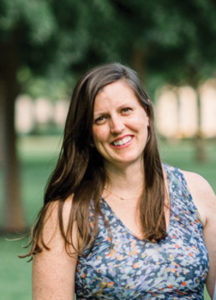
Photo courtesy Margery Gosset.
What led you to pursue a career in the arts?
I grew up in Midland, Texas. We didn’t have a lot of art there, but we did have the Museum of the Southwest, and my family was always encouraging us to look at art books. My dad is originally from New York. We would travel there occasionally and go gallery hopping, and so art has always been a part of my life.
Later I went to SMU and was a fine arts major. I studied some art history but really focused on drawing and printmaking. After that, I attended the School of the Museum of Fine Arts at Tufts University, in Boston. I studied curating and worked for a gallery there.
I moved to Fort Worth in 2007. My family knew [111 co-founders Daniel and Dennis Blagg], but I had never been here before. They had a small gallery, but it was mostly artist studios from 1980 until I arrived. I collaborated with them on a few projects and eventually expressed interest in taking over the gallery. They were ready to step away from that part of the business and focus on painting. It was a wonderful moment.
I was 24 and not exactly sure how to run the business, but the Blaggs were always there. They’ve been great mentors. For the first five years, they sort of held my hand until they could slowly back away. You could see a bit of relief on their faces every time I hung a show without leaning on them too much.
What about the day-to-day work/life balance and having it all?
I never really say that I’m going to work. I always say that I’m going to the gallery because every day is different. We’re constantly running around and moving art. It’s very labor-intensive and definitely not a behind-the-desk-type of job.
Being an art major, I don’t do a lot of painting or drawing currently, but curating is my creative outlet. Every six weeks we have a new exhibition. Everything has to come off the walls, and you have to clean and care for the walls. Then the new artwork comes in, and sometimes it’s wrapped in plastic or in a box, and it’s like Christmas. You get to open everything and lay it all out. That’s always an exciting time.
I’ve been here 12 years now, and it’s become a part of my life and my kids’ life. It’s fun to have them grow up in this environment. They love to draw, and they’re always creating. I do believe women can have it all. Sacrifices have to be made, but I like for my kids to see me working. I like for them to be a part of what I’m doing, but it’s a juggle every day. I never know my schedule.
What about career challenges?
I was very young when I started, and I think a lot of people were questioning my longevity. I don’t really have a business background, but I overcame those challenges because you have to. You have to figure it out, and so I did. I put myself in a difficult position, but I also surrounded myself with the right people. When we first started, Dan and Dennis helped me to learn the business, and John Hartley’s wife helped with our marketing. I found a great CPA to help with finances.
One nice thing about Fort Worth and the gallery community is that everyone is very supportive, and I have some great people to look up to like Pam Campbell [at William Campbell Contemporary Art] and Cheryl Vogel at Valley House in Dallas. Everyone’s been so friendly and kind. My advice would be to find people who are in your position or people who have been through what you’re going through and just talk to them because they’re willing to share.
Please name one proud moment or accomplishment.
Running a gallery, you have a responsibility for all of these artists. It’s a lot of pressure, but it’s also something to celebrate — to give them this space, provide them with clients, and bring in new collectors. Sometimes I look up, and I think, Wow, I have 25 babies.
And sometimes I think about being here in 2007-2008, and it was a combination of me and me calling my brother to come help me take out the trash and just trying to get through every day. Now we have a team of event consultants. Our lead coordinator, Brandi Chapman, helps us grow that side of the business. We recently hired a gallery manager, Ariel Davis. She’s stepped in to help with the day-to-day at the gallery, while … my brother and partner here, he and I have embarked on creating a new consulting side of the business. It’s fun to look up and realize that we’ve created this little community that makes all of this work because it’s impossible to do alone.
Any advice for artists?
I’m actually a very shy person. As a young gallery owner, I didn’t really know anybody in the art community. I had to put myself out there and go to openings and meet people. It took me a couple years to get used to doing that and find a way to enjoy it. It was something that I had to overcome. And so I always try to encourage young artists to go out there and meet people because that’s the way things happen around here. I think it’s important to become familiar with the different galleries in your community. If I can do it, you can do it.
What are your upcoming projects?
We’re celebrating our 40th anniversary, and this whole year is a kind of celebration. We just opened a show called Studio111. That’s what they called the gallery back in the day. The show includes work by 15 of the artists who had studios here in the ’80s and ’90s. … We’ve also just added four new artists: Dennis Farris, Layla Luna, Robert McAn, and Jon Flaming. We’re excited to welcome them and show their work alongside our other artists.
Andrea Karnes
Andrea Karnes is senior curator of the Modern Art Museum of Fort Worth. Born and raised in Fort Worth, Karnes earned degrees in art history at UNT and TCU. She joined the staff of the Modern in 1989 as a receptionist and worked her way up, eventually serving as research assistant, assistant to the registrar, registrar, assistant curator, associate curator, curator, and senior curator since 2017. Karnes is the curator of such landmark exhibitions as KAWS: Where the End Starts, México Inside Out: Themes in Art Since 1990, and Laurie Simmons: Big Camera/Little Camera. She is the proud mother of two children.
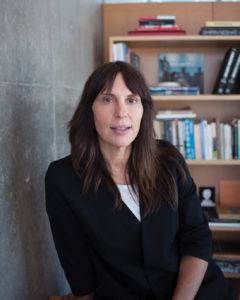
Photo courtesy Modern Art Museum of Fort Worth.
What led you to pursue a career in the arts?
My mother took me to Italy when I was 12. I think it was my first time on a plane. My mother was first-generation U.S., but she had never visited her relatives in Italy. I saw so much on that trip: sculpture, frescoes, things that I had never seen before, and I really started to understand that all art comes from the culture and history of the moment in time when it’s made. Once that clicked, I think that is when I became interested in art.
Then, in high school, I was an exchange student for a year in Holland, and I was able to take art history courses. I lived with a Dutch family in Rembrandt’s hometown of Leiden, and I think I visited every museum that I could get to by train that year. That really cemented my interest.
When I came back, I majored in art history at UNT and later again in graduate school at TCU. I grew up going to the museums here, and when I graduated from UNT, there was an opening at the Modern Art Museum in our old building for a receptionist. I applied for the job, and I got it. That was in 1989, and so I’ve been here a really long time.
In addition to answering the phones, my job was really to support the entire staff because it was tiny. Nobody did internships back then, and so getting my foot in the door was the ultimate thing I could do. I’ve been very lucky to be able to evolve with the museum.
What about your day-to-day experiences?
Every exhibition that we put forward is very carefully considered. There’s a lot of negotiating that goes on all the time, negotiations within the institution when you’re arguing for an exhibition that you want to do to the director, the curatorial team, or the board. Then there are negotiations with other institutions, if you want to borrow things from them or you’re sharing an exhibition. There are negotiations with other lenders, such as galleries, artists, or private collectors. Every exhibition — let’s say it has between 50 and 100 works. There’s a lot of negotiation behind each of those objects. That’s a big part of the job.
What are your career challenges?
Looking back, there were exhibitions like México: Inside Out where I thought, in the beginning, I can’t do this. I’m not a Latin Americanist. I’m not Mexican. Then I thought, maybe I’ll do a show about women artists, and that’ll be my point of access. But after visiting artists a few times in Mexico, I realized that I didn’t have to have an in.
This is contemporary art. It’s what I do. I don’t need another in. All I have to do is know my stuff, but it took being brave and going through those phases of saying, “Well, I’m not an expert in this field in particular. I’m not this, and I’m not that,” and that’s OK, as long as I know what I’m doing and why and the artists are on board. Know your stuff and be brave. If you know your stuff, it’ll come across, and if you don’t, it’ll come across.
Please name one proud moment or accomplishment.
I am most attracted to contemporary art because I feel like it’s impactful right in the moment that we’re in culturally, and most of the time, I get to collaborate with a living artist. What is super-interesting to me is helping an artist touch a new audience. I’m just a facilitator. I’m not making the work. I’m just here to advocate for artists and their work.
A couple of years ago, I organized an exhibition with Laurie Simmons. We worked on it for about three years together, and then it opened here and traveled to Chicago. Laurie is someone who’s been creating work about prescribed gender roles for 40 years, but when the show opened, it was sort of on the tip of everyone’s tongue as a topic. And I feel like I saw a lot of young women in the museum who were artists or studying art history or studying art on some level who were really empowered by seeing an entire floor filled with one woman’s art.
Any advice for artists?
I think being OK with wherever you are in your career is the No. 1 thing. Artists have to take so much rejection. I don’t know how they do it. Laurie Simmons worked through the ’80s when it was all about men. … Even when she had no market at all or a down market, she continued to make series after series. In the end, it paid off, but she had to be patient.
Try not to worry about the outside pressures, but at the same time, be able to advocate for yourself until you get a gallery or museums advocating for you. Be able to articulate what you’re doing and why. Show up for events, talk to people, and maybe tell them something about your work, if they’re looking at it, not how to think about it, but I think it’s important to be able to self-market.
What about upcoming projects?
We’re about to open the Mark Bradford exhibition. He’s an international superstar now, and we’ve got a whole floor of his work. It’s not my show, but I think that’s very exciting for our community. I’ll also be installing some new acquisitions this fall. I can’t say which artists yet, but it will involve some women artists, and I think that will be very exciting in the coming year.
We will also be a venue for the Shirin Neshat exhibition organized by the Broad Foundation. I’ll be working closely with their curator, Ed Schad, for the presentation here. It’ll be very intricate and involved with a lot of videos and photographs. Shirin is a Persian artist who escaped Iran during the revolution and has been separated from her family ever since. Much of her work is about that recovery process from being uprooted from her home. I think it’s important to show work like that here. She’s a woman artist, but she also has this other layer of her story about being an immigrant. Her work is not only beautiful, but it also has a lot of important cultural messages that impact a lot of people in Dallas-Fort Worth and beyond.
Karen Wiley
Karen Wiley is president and CEO of the Arts Council of Fort Worth. Born and raised in San Antonio, Wiley earned degrees in studio art at Texas Tech University and the University of Oregon. Prior to moving back to North Texas and beginning her appointment at the Arts Council in 2015, she served as executive director of the Louise Hopkins Underwood Center for the Arts in Lubbock (2008-2014); executive director of the Western Heritage Museum in Hobbs, New Mexico (2004-2007); director of finance/administration and general manager of The Sixth Floor Museum at Dealey Plaza (1990-2004); and executive director of the Buddy Holly Center in Lubbock (1985-1989).
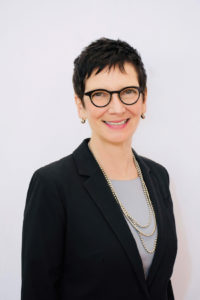
Photo by Rachel Delira.
I’ve always been an artist. Starting as a very young child, I was working in Grumbacher pastels and doing clay classes. I have severe dyslexia, and so learning how to communicate through the arts became an everyday experience for me. I always say that art was my first language and English was my second.
Porcelain sculpture was my major and watercolor was my minor. I also ran the galleries for the University of Oregon. I fell in love with that job, and when I graduated and started looking for positions, nonprofit seemed to be a natural fit. I knew what the arts could do for an individual because I was the living proof. To give back and see a community grow, to see people flourish through the arts and find voice in the arts, that has always been important to me.
What about the work/life balance and having it all?
Balance is the hardest thing. My yard is my sanctuary. It’s very important that I go outside and have my hands in the dirt probably because I was a clay major. I want that tactile feeling. I read, I draw, I cook. I have a dog that I adore. We walk. My nephew and his wife live here, and they have three precious children. They fill me up. They love art, they love to play, and when you’re with them, you forget everything else. It’s amazing.
Having it all? Do they ask men that? They don’t. Do they? I think that whatever you want, that’s what you go for, and that’s what you get. And none of us get everything we want. What were your goals? Did you achieve those? But then, what’s next? You don’t just stop. Life goes on, and life changes, and we go through periods of loss and gain. There are seasons in a life, and you’re going to experience those seasons. At any point, does anybody really have everything?
What are some career challenges?
I started off on a good foot because I had a mother and father who told me I could do anything I ever wanted to do and believed in me. But I’m 5-foot-2, a little over 100 pounds, and I remember walking into board meetings full of big men in their suits, and I in my suit, and, well, you just have to puff yourself up.
I think it’s something that we all have to do, to say I have a right to be here and I have something to say. You are a person of worth. And you say, “I respectfully want to hear what you have to say, and I ask for that in return.” Whenever I’ve felt discriminated against or devalued, I lean in. Lean in, speak softly, make eye contact, and state your case. No one can make you feel unworthy. Just be yourself. People will love ya. Just be you.
Please name one proud moment or accomplishment.
I am honored to say that I have just celebrated my fifth anniversary with the Arts Council. I’ve always viewed my position, this organization, as a composition. I look at it through the eyes of an artist — how it can ebb and flow and how you find the strengths of individuals around you to move the organization forward.
We’ve built a strong team and done a lot of cross-training. Now we’re doing a lot of cross-development of programming and drawing on the skills and talents of the staff. It’s really exciting, and I’m very proud that we have done that. When I arrived, I could see where we were and where we needed to be. We had to very gingerly break the shells and mix the eggs. I have learned that the slower you go, the faster you’ll get there. … Observe, listen, and begin to formulate, but don’t push. You want to bring people with you. Until it’s a unified effort, you’re just not going to get there in the way that you need to.
Any advice for artists?
I think it’s important that artists know that they are valued and that they are a vital part of the community. They are our storytellers, our historians. They are telling people who they are. … Value yourself, and I know that’s hard because you’ll always have some people say, “We’ll do this fundraiser, and we know this artist that can do this. They can donate this and that, and it’ll be good exposure.” Don’t devalue them. They’ve given their time and their talents. This is their profession. You don’t ask an attorney or a doctor to donate their expertise. I want artists to stand up and say, “I’m valued in the community.” Artists need to receive compensation. We need to support them just like any small business.
What are your upcoming projects?
When I arrived five years ago, it was apparent to me that a lot of people didn’t know who we were or what the Arts Council did. The organization was founded in 1963, and, like any other, it ebbs and flows in different ways depending on the needs of the community, and so we are currently going through a rebranding, and we’re changing our name.
We did little groups and a lot of surveys that came back and said that “Arts Council” sounds too government. I’ve always said that we’re not a council. We roll up our sleeves, and we are down there in the fight. We are doing our advocacy. We are working for our artists, and we want to be seen that way.
We’re also developing an educational program that I think is very strong. Last year, we offered classes and workshops on diversity and inclusion, financial management, storytelling, and two on public art for artists. We’re planning to offer another series for the visual arts, the performing arts, arts organizations, and nonprofits as a whole.
We also have a new gallery, our outdoor sculpture garden. Thanks to our sponsors, Sheila and Houston Hill, two sculptors, Ben Muñoz and Jihye Han, are exhibiting their work out there for about a year. We’re very excited to offer this opportunity to other emerging artists in the future and present their work in a prominent place here in the Cultural District.
We’re also currently piloting an artist-in-residence program. Eventually, we hope to host artists here for a year in addition to our art collective residency. And we’re always looking for new ways to engage with artists. We want to be what this community needs, and so please visit us, email us, call us, set up an appointment. We’re here. We want to hear from our growing community to help us change and move forward.



